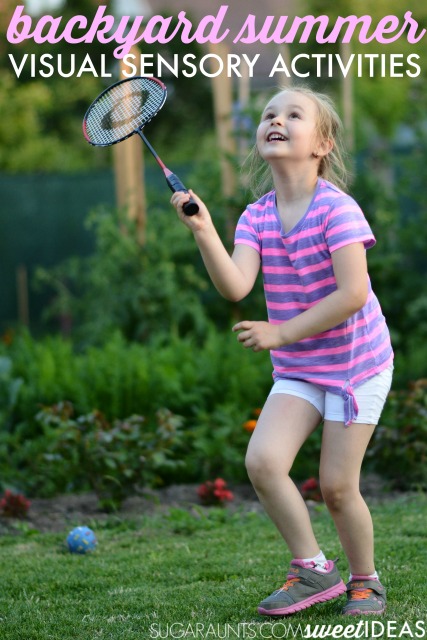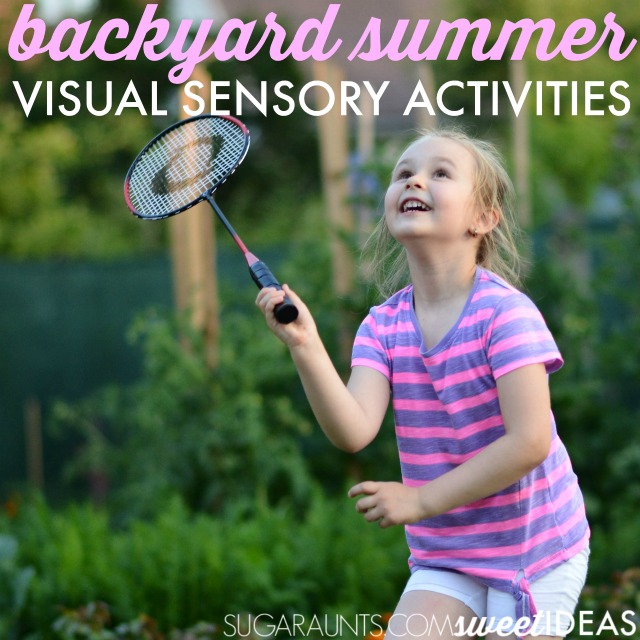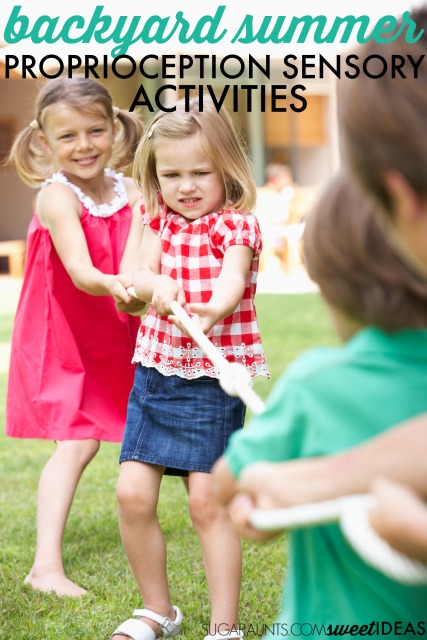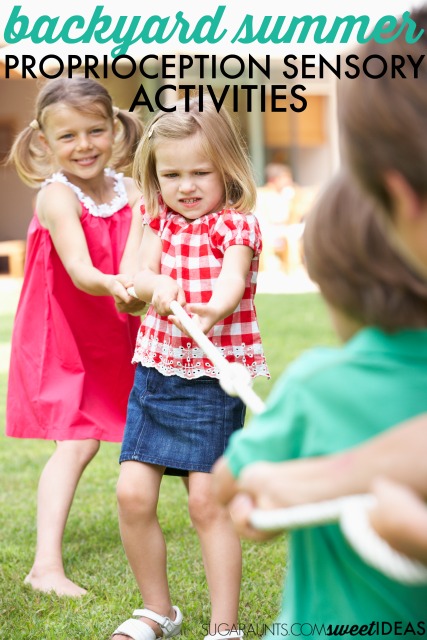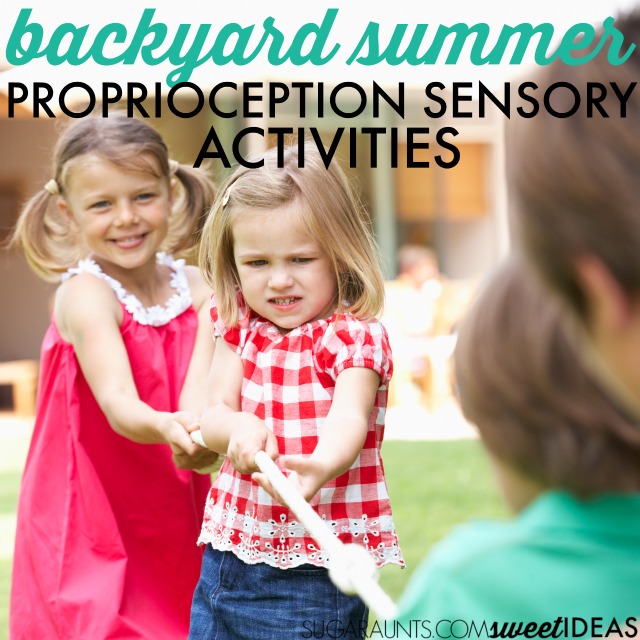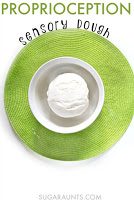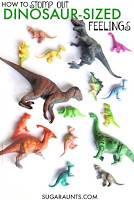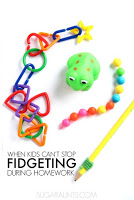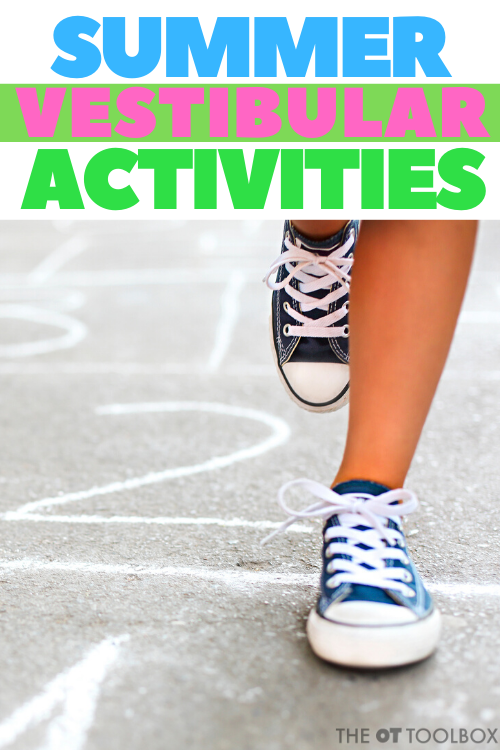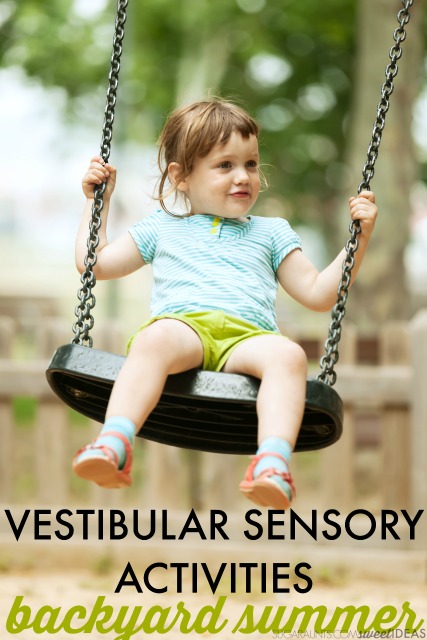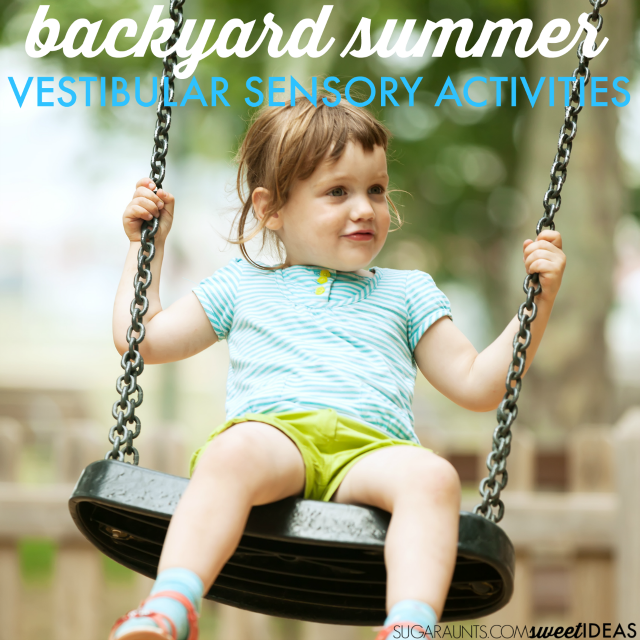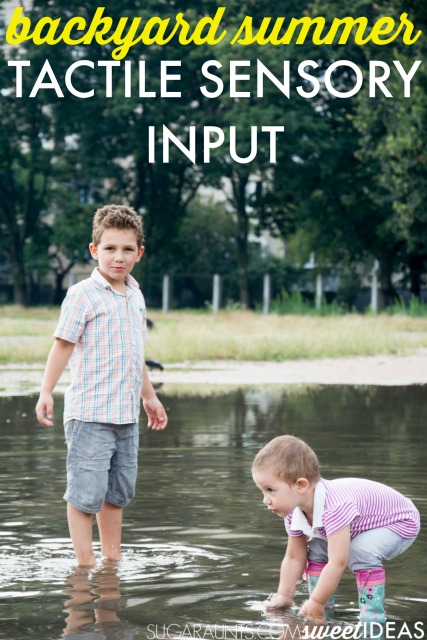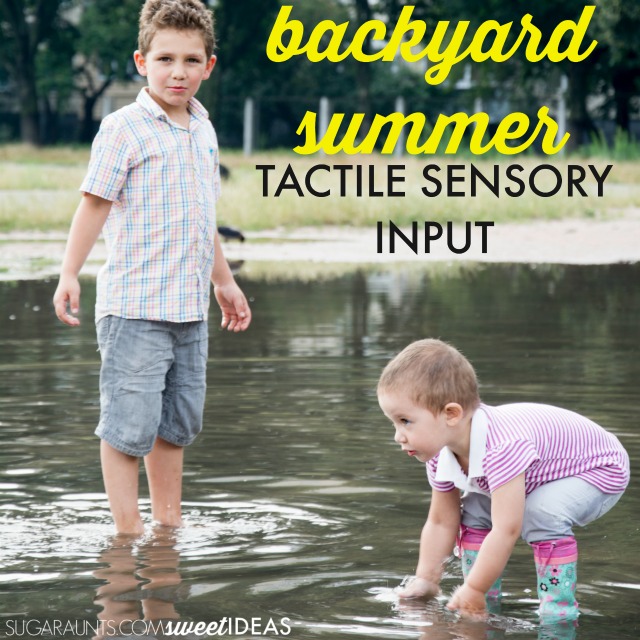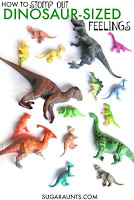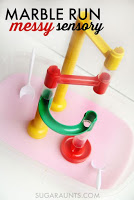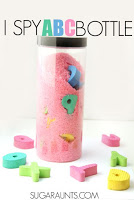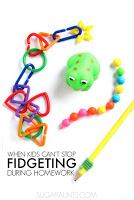If you are looking for outdoor sensory activities, this is the place to start. Here, you’ll find outdoor sensory ideas to address each sensory system. Also included are sensory play ideas to use in the backyard when creating an outdoor sensory diet for children.
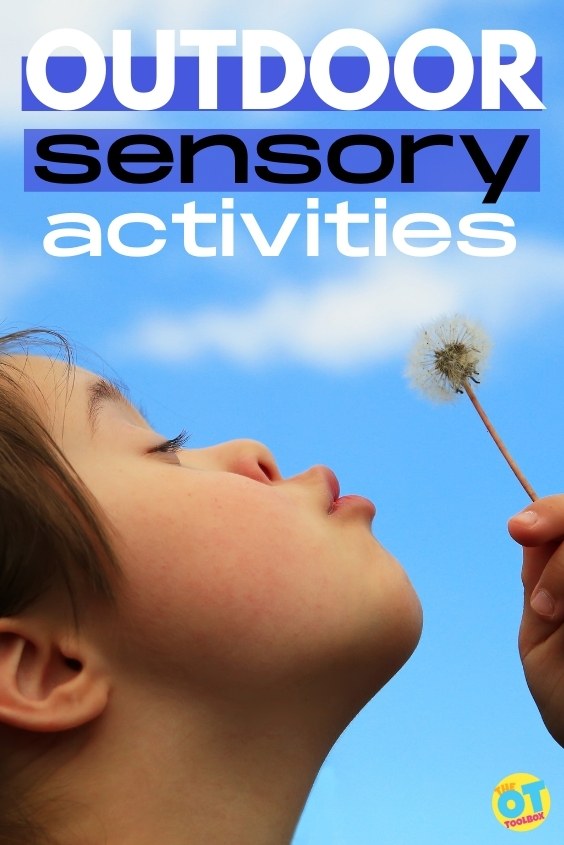
Outdoor Sensory Activities or a Sensory Diet?
So often, kids are sent home from therapy with a sensory diet of specific activities and sensory tools that are prescribed for certain sensory processing needs. When a therapist creates a home exercise program, they do their best to ensure carryover through small lists of activities, parent education, and
motivating activities that are based on the child’s interests and personal goals.
The important thing to recognize is that there is a difference between sensory play and sensory diets. Read here for more information on what a sensory diet is and isn’t.
When therapists develop a specific and highly individualized sensory diet, it’s not just throwing together a day filled with sensory input. A sensory diet is a specific set of sensory tools used to meet and address certain needs of the individual based on sensory need and strategizing.
Each of the sensory diet activities above should meet specific needs of the child. Every child is different so applying sensory input to one child may look very different than that of another. Parents should use the tactics below along with your child’s occupational therapist.
So, using sensory diet tools within the context of environments or activities that are deeply meaningful to a family and child such as play that is already happening, can be the meaningful and motivating strategy to actually get that sensory diet task completed. And it benefits the child along with the whole family.
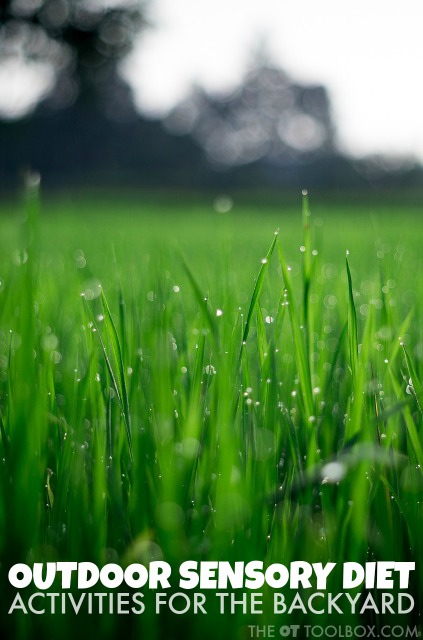
Outdoor Sensory Activities
These outdoor sensory activities are those that can be included into backyard play. That may look like independent play by the child or it might mean family time on a Sunday afternoon. Use these outdoor sensory diet activities in the backyard to as sensory tools that double as playtime for the child while he/she learns and grows… or to meet the sensory needs of the child while creating memories and enjoying time together!
Below is a huge list of outdoor sensory activities, but to focus on each sensory system, check out these resources:
- Outdoor sensory activities for proprioception
- Outdoor sensory activities for vestibular
- Outdoor sensory activities for visual processing
- Outdoor sensory activities for oral motor skills
- Outdoor sensory activities for auditory processing
- Outdoor sensory activities for tactile input
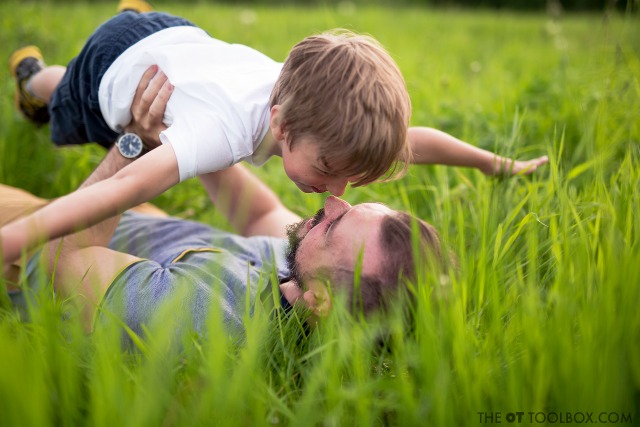
Bakyard Sensory Activities
- Slide down a hill on cardboard
- Grass sensory bin
- Use a magnifying glass to inspect the grass and dirt
- Mud kitchen
- Roll down hills
- Animal walks with bare feet
- Create nature “soup” with grass, flower petals, sticks, etc.
- Pick flowers
- Cartwheels and tumbling on the grass (barefoot or with shoes!)
- Water Table with nature
- Cartwheel or tumbling
- Target games
- Outdoor lawn games
- Bean bag games
- Relay races
- Hide and seek games
- Simon Says games- Print off these Simon Says commands.
- Tag
- Bell parade
- Kazoo sound hunt
- Listening for birds or animals
- Record backyard sounds and playback the recording. Try to recognize and name the sound and where it was located in the yard.
- Fill containers with items from the backyard. Shake plastic containers or even paper bags with the items and see if your child can name the objects.
- Play Marco Polo in the yard!
- Auditory backyard games like: Neighborhood Listening Scavenger Hunt, Auditory Hide and Seek, Listening Tag, Noisy Toy Positioning Game
- Create with recycled materials and make arts, crafts, and activities.
- Pull plastic ware out of the cupboards and sort the lids onto the containers. Mix colors with food coloring in water.
- Blow bubbles
- Jump rope
- Play Kickball
- Throw a book picnic: grab snacks, a blanket, and a pile of books and head outside.
- Dress up with old fancy dresses and clothes from mom’s closet (then throw them in a bag and donate!)
- Bake
- Poke holes in a cardboard box and push pipe cleaners through the holes
- Bowl with recycled plastic water bottles
- Act out a favorite nursery rhyme
- Play tag games for heavy work, spatial awareness, and body awareness.
- Put dollhouses or play sets into a bin of shredded paper.
- Play hide and seek
- Climb trees
- Watch and draw clouds
- Tell stories where one person starts a story and each person adds a sentence to continue the story. Write it down and illustrate your story!
- Make and deliver lemonade to neighbors
- Go birdwatching
- Make creative firefly catchers and then catch the fireflies that night.
- Play charades
- Act out a favorite book
- Create with finger paints (make your own with flour, water, and food coloring or washable paint!)
- Sing songs
- Turn on music and dance
- Pick flowers and give them to neighbors
- Make summer crafts that build skills.
- Have an art show and invite friends.
- Create a spatial concepts map
- Spin in circles.
- Swing side to side on a swing set.
- Hang upside down from swing set equipment.
- Swing on a hammock.
- Backyard dance party. Encourage lots of whole body movements and spinning.
- Cartwheels
- Tumbles
- Hopscotch
- Play Leapfrog
- Mini trampoline (or the big sized-trampoline) Catch a ball while standing, sitting, swinging, rolling a ball, catching between legs, etc.
- Hit a tennis racket at a target including bubbles, falling leaves, large balls, small rubber balls, and balloons
- Catch butterflies in a net
- Bubble pop, including popping bubbles with a toe, knee, foot, head, finger, or elbow
- Play with goop
- Draw in shaving cream on a cookie sheet outdoors. Then squirt off in the hose.
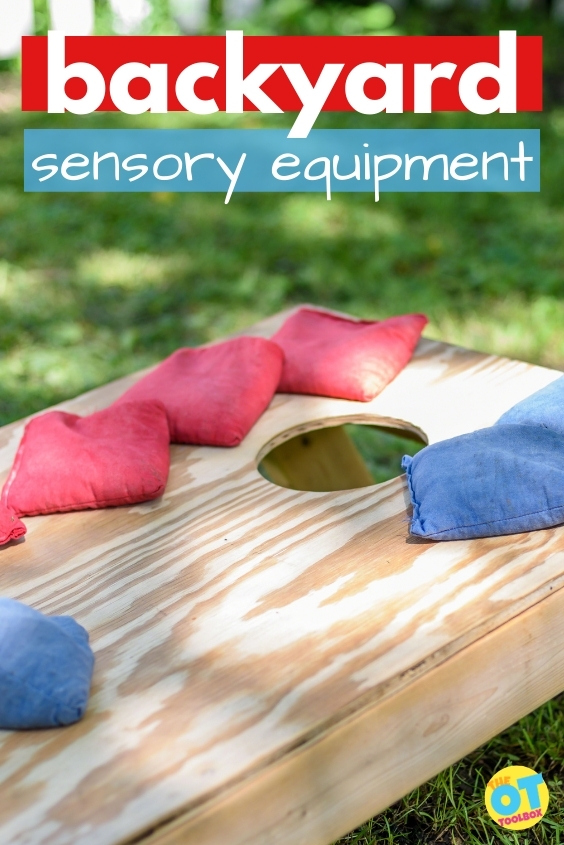
Backyard Sensory Equipment
There are outdoor play items you may have already that can be repurposed to use in outdoor sensory play. These are common backyard toys or things that might be in your garage! It can be fun to re-think these items for a means of adding sensory input.
Make a bin of outdoor toys that are readily available in your garage or storage area so that sensory play experiences are at your family’s fingertips. For example, all of these items could be used in an outdoor balance beam.
- Hoola Hoops
- Jump Ropes
- Balls
- Bat
- Tennis Racket
- Butterfly Net
- Baby Swimming Pool
- Tarp or Slip and Slide
- Water Hose
- Scoops and cups
- Sidewalk chalk
- Bike
- Scooter
- Skateboard
- Cardboard
- Target or net
- Shovels
- Buckets
- Play wheelbarrow
- Swing set
- Climbing structure
- Flashlight
- Magnifying glass
- Cones
- Bubbles
- Bean bags

Outdoor Sensory issues
Summer can mean sensory processing issues that impact kids with sensitivities or over responsiveness to sensory input. For autistic children or anyone with a neurodiversity that impacts sensory processing, summer can mean a real hatred for being outside in the hot summer months.
So what are some of the reasons that sensory kids have issues with being outside during the summer?
It can be hard to encourage outdoor play (and gain all of the benefits of outdoor play) when the summer months add a different level of sensory input. Here are some of the reasons that sensory kids are challenged in the summertime:
For kids with sensory needs, it can be overwhelming to have an open space full of sights, sounds, scents, and textures.
- Tolerance of the cuffs of shorts or sleeves
- Tight bathing suits
- Sensation of sunscreen
- Sensation of socks or other clothing in hot weather
- Humidity changes
- Summer thunderstorms (can change the air temperature)
- Short clothing that brushes on legs or arms
- Sandals or open-toed shoes
- Crowds or places where others are in close contact
- Wearing a mask in warmer temperatures
- Honking horns, barking dogs, and other sounds that frequent the backyard or lawn can be too much for the child with sensory sensitivities
- Bright sun that is at a different angle in the sky than other months of the year
- Overwhelming smells: cut grass, lawnmower gas, sunscreen, sweat, body odors, garbage scents
- Interoceptive issues with body temperature, increased need for water, less hunger due to heat
All of these sensory issues can occur unexpectedly and that unexpectedness of sensory input can be overwhelmingly alarming for those with autism or neurodiversity.
How to help with summer sensory overload
- Visual schedule
- Help the child know what to expect
- Wear shoes instead of sandals or bear feet
- Proprioceptive input such as firm touch to the shoulders
- Limit time outdoors
- Know triggers for sensory overload and plan ahead when possible
- Oral motor jewelry
- Communicate travel or outdoor time needs
- Calming vestibular sensory input such as side to side or forward-front slow swinging
- Play that involves throw and play catch with a weighted ball
- Bucket of water to rinse hands if child is sensitive to messy hands or dirt
- Sheltered area if child is sensitive to wind blowing on skin
- Wear a lightweight wind jacket
- Bring a water bottle with straw for proprioceptive input
- Calming or alerting snacks
- Portable fan to help with overheating if needed
- Hat with brim to reduce bright light or intense light in eyes or on face
- Umbrella to deflect direct sun rays and prevent overheating
- Sunscreen with firm touch before going outdoors
- Scent free sunscreen
- Sunscreen lotion vs. spray sunscreen (or vice versa depending on the particular needs and preferences)
- Sensory friendly clothing, bathing suits, goggles
- Wear sunglasses
- Wear headphones to reduce background noise
- Be aware of freshly cut grass which as a strong scent
- Wear thin gloves for tactile activities
- Use water shoes or crocks instead of sandals
More about outdoor sensory diet activities
Sensory diets and specific sensory input or sensory challenges are a big part of addressing sensory needs of children who struggle with sensory processing issues. Incorporating a schedule of sensory input (sensory diet) into a lifestyle of naturally occurring and meaningful activities is so very valuable for the child with sensory needs. That’s why I’ve worked to create a book on creating an authentic and meaningful sensory lifestyle that addresses sensory needs. The book is now released as a digital e-book or softcover print book, available on Amazon. The Sensory Lifestyle Handbook walks you through sensory diet creation, set-up, and carry through. Not only that, but the book helps you take a sensory diet and weave it into a sensory lifestyle that supports the needs of a child with sensory processing challenges and the whole family.
Get The Sensory Lifestyle Handbook here.
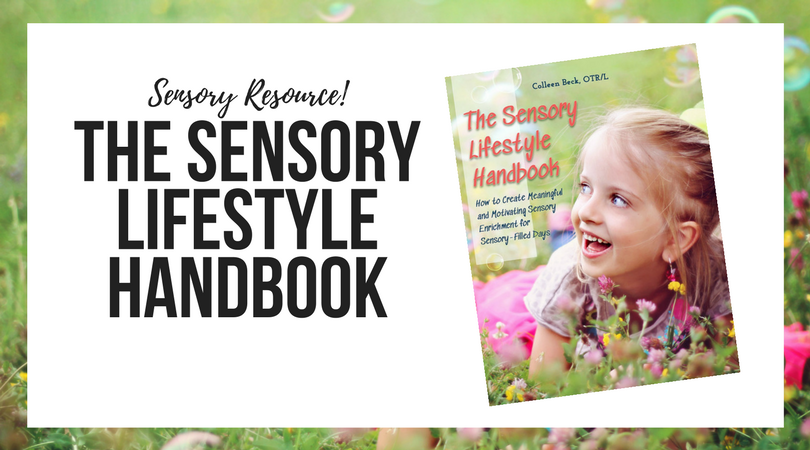
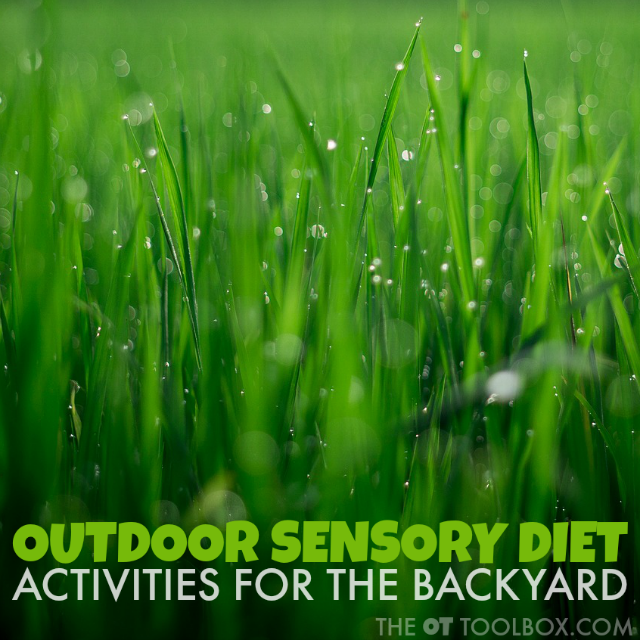

Colleen Beck, OTR/L has been an occupational therapist since 2000, working in school-based, hand therapy, outpatient peds, EI, and SNF. Colleen created The OT Toolbox to inspire therapists, teachers, and parents with easy and fun tools to help children thrive. Read her story about going from an OT making $3/hour (after paying for kids’ childcare) to a full-time OT resource creator for millions of readers. Want to collaborate? Send an email to contact@theottoolbox.com.


